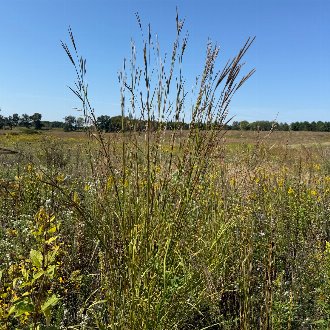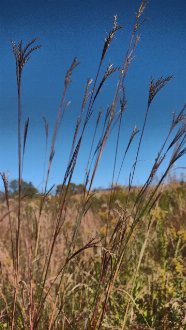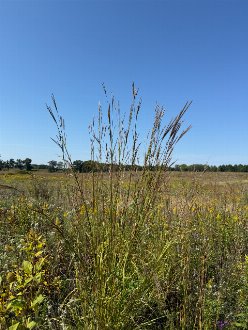Big Bluestem (Andropogon gerardii Vitman)
Also classified as Andropogon gerardi (Alternate Spelling).
↑Summary
A tall, perennial, warm-season grass native to North America with a wide range stretching from the great plains into the mountain west and to the east coast.
↑Range - Expand
| Legend | Color |
| Native | |
| Native or Not Present |
This tentative map is based on our own research. It may have limited data on Canada and/or Mexico, and there is some subjectivity in our assignment of plants as introduced vs. expanded. Read more in this blog post.
Although this plant occurs somewhere in each of these regions, it may only occur in a small part of some or all of them.
↑Habitat
One of the dominant grasses of prairies, especially mid-to-late successional tallgrass prairies in the eastern great plains; in this region, it is most dominant on mesic sites. In the drier, western portions of the great plains, dominant only on moister bottomland regions. Even farther west, found in savannas and open forests. Also found in a wide range of other habitats, including roadsides and fallow fields. In the mostly forested east, less common and mostly limited to open habitats including cliffs, limestone glades, sandstone barrens, and other rock outcroppings, as well as floodplains, meadows, and shores of lakes and rivers, as well as various habitats that have experienced recent canopy-removing disturbance, but that have significant herbaceous vegetation and organic matter in the soil.
Throughout its range, including in the east, also found in anthropogenic habitats including roadsides and railroads, overgrown cemeteries, and fallow or abandoned fields.
Prefers soils ranging in texture from silt-loam to clay-loam, and rich in organic matter. Tolerates, but is less dominant on a wide variety of other soils, including clayey and rocky soils. Able to grow in calcareous blackland soils, where its growth is stunted but it sometimes still competes favorably against other plants whose growth is similarly limited. In parts of the west, often found growing on the south side of large rocks where drainage off the rocks increases available moisture from rainfall. Tolerates a wide range of soil pH from alkaline to moderately acidic, but absent from the most acidic soils. Tolerant of air pollution.
Typically limited to later-successional stages of grassland communities. It requires significant organic matter in the soil to establish, and its dense growth at the ground level, and shade tolerance makes it competitive against other grassland vegetation, and hinders the establishment of competing vegetation.
Prefers habitats that experience regular fire, especially in the spring but any time from fall to spring. Less adapted to and less common in habitats that burn more than once every 2 years, or that burn during summer, as both of these hinder this species growth. Usually also absent from sites that burn or experience other vegetation-removing disturbances less than once every 5 years.
Highly tolerant of light grazing by mammals, but not tolerant of regular grazing below about 6 inches in height.
Historically this grass was the single most dominant plant in tallgrass prairies of North America, making up over half the total biomass on most sites.
↑Life Cycle
Big bluestem is a long-lived, perennial, warm-season grass that relies on C4 metabolism. It can grow both as a bunchgrass or a rhizomatous sod-forming grass; the spreading rhizomatous form is more common over much of its range, whereas it grows as a bunchgrass primarily in the more arid west.
Plants grow slowly late in spring, typical for C4 plants, with growth only picking up in the warm weather; in late spring to summer this plant grows to its full height. Plants bloom in late summer to early fall, usually for a period of up to two weeks. Flowers are wind-pollinated.
Reproduction is primarily vegetative. In a typical year, relatively few shoots flower and produce seed. However, seed production varies heavily year-to-year, based on conditions. Seed production is highest in a moist year, and also peaks in the year immediately following a fire, as fire tends to benefit this plant by removing competing vegetation.
On sites where this species is already established, seed germination is poor, as is persistence in the seed bank. However, reproduction from seed is important at helping this species establish on new sites.
Individual plants persist for many years, possibly persisting for centuries, although the lifespan of this species has not been studied rigorously.
↑Faunal Associations
The foliage was historically a key food for bison, and is also eaten by the meadow vole and prairie voles; nowadays it is an important forage for cattle and other livestock. It is consumed to a lesser degree by deer and rabbits.
Numerous insects also eat the foliage. Because of the large amount of biomass this grass produces, it is a key food source for many generalist insect herbivores, including grasshoppers.
↑Uses
Occasionally used as an ornamental grass, especially in native plant gardens, where it is valued for its drought tolerance. Stems sometimes flop over late in the season, when not supported by other vegetation.
Also planted in prairie restorations, including those looking to create prairie-like habitat along roadsides.
Sometimes used for erosion control, on sites suitable for its establishment, which exclude the most degraded sites with heavy soil disturbance. Where it is able to establish, this species is effective at holding the soil due to its expansive root system.
Because this species has a large range with a great amount of variability in adaptations to local conditions, it is best to find as local a source population as possible, ideally gathering seeds from a local population. Numerous cultivars exist, but most will fare poorly if planted far from their region of origin.
↑Related Plants
Numerous other Andropogon species are found in North America, all native. The most widespread of these, which overlaps in range in the eastern to central US, is broomsedge bluestem (Andropogon virginicus), a species which occupying an earlier successional stage of grasslands.
↑Links & External Resources
• Big Bluestem | Fire Effects Information System (FEIS) (About This Site)
• Andropogon gerardii (Big Bluestem) | Illinois Wildflowers (About This Site)
• Andropogon gerardii (Big Bluestem) | USDA PLANTS Database (About This Site)
• Andropogon gerardii | Go Botany (About This Site)
• Andropogon gerardii (Big Blue Stem) | Missouri Botanical Garden Plant Finder (About This Site)
• Andropogon gerardi | Biota of North America Project (BONAP) (About This Site)
• Andropogon gerardii | NatureServe Explorer (About This Site)
• Andropogon gerardii | Flora of North America (About This Site)
• Andropogon gerardi | Missouri Plants (About This Site)
• Big Bluestem | Maryland Biodiversity Project (About This Site)
• Andropogon gerardii Vitman (Big Bluestem, Turkeyfoot) | Digital Atlas of the Virginia Flora (About This Site)





